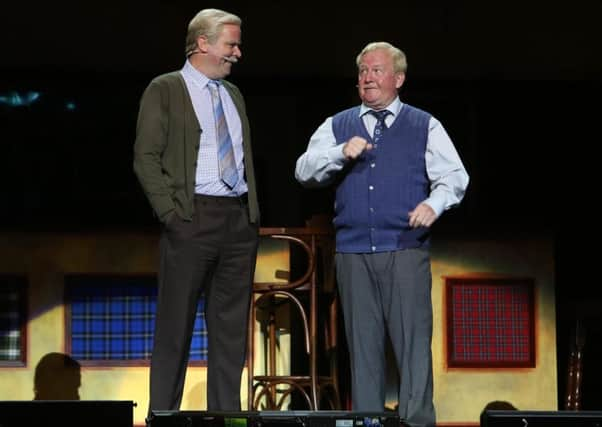Joyce McMillan on the huge appeal of Still Game on stage


The date was Friday 19 September 2014, the evening after the day before, when all Scotland had just spent a sleepless night watching the results of the independence referendum. The nation was still reeling from the political shockwaves, there was a minor unionist riot in George Square, and the police were out in force, iron budgie (or Glasgow police helicopter) and all.
Along at the Scottish Exhibition Centre, though, one aspect of Scottish life and culture remained firm as a rock, and completely unflappable; for on the stage at the giant Hydro arena – a 12,000 seat sports hall and rock venue more used to the sounds of Beyonce on tour – the inimitable Jack and Victor of the smash-hit television comedy Still Game were about to launch their first-ever stage show. And the show’s writer-performers Ford Kiernan and Greg Hemphill were not contenting themselves with a standard-sized rumble around the stage at the Pavilion or the King’s. Instead, they were taking on an auditorium eight times as big as the average large receiving theatre, and creating a show – with director Michael Hines – that pioneered an entirely new format, combining live narrative theatre with smartly-edited elements of the live action projected on huge screens around the auditorium, filmed background material ranging from dressing-room snippets to spoof travelogues about Still Game’s fictional community of Craiglang, and a dream-sequence Bollywood finalé fit to blow the audience’s collective 12,000-strong mind.
Advertisement
Hide AdThe result received mixed but respectful reviews – no-one had ever seen anything like it, and the storyline about internet novice Jack trying to Skype his way into giving a speech at his daughter’s renewal of vows in Canada had a fair amount of satirical bite. In terms of the paying public, though, it was a staggering success, with a total audience, over 21 shows, of almost a quarter of a million, and more than £6 million taken at the box office. That means, for example, that Still Game 1 dwarfed by a factor of 20 or more the possible box office achievement of major Scottish producing theatres like the Lyceum and the Citizens’, whose most successful shows can never expect to play to more than around 10,000 people over three weeks.
And now, in the spring of 2017, it’s all happening again, as Jack, Victor and their merry band of Craiglang pensioners launch Still Game 2, scheduled for 15 performances at the Hydro this month. Kiernan and Hemphil are playing their cards close to their chests when it comes to details of the sequel, titled Bon Voyage! They claim, though, that it’s set to be a much more risky, experimental and theatrical show than its predecessor; and that since the show will have no further life after the Hydro, fans are just going to have to be there to see it. Ticket prices are high, currently ranging up to £55 and beyond; yet Still Game 2 seems set for another huge box office success, as crowds from all over Scotland rush to see their heroes live – or at least on a large screen close to them.
“I really never imagined that Still Game could be a live show of this size,” says Glasgow writer and performer Sanjeev Kohli, who plays shopkeeper Navid in the show. “I’m not sure anyone has ever tried before to do narrative theatre on this scale, and I do think it’s a new format, some kind of hybrid that doesn’t have a name yet. Because I don’t have a lot of stage experience, I think I was less nervous than the rest of the cast in some ways; essentially, this is a stage show for perhaps 400 people near the front, and for the rest it’s something else, live but mediated through the screens. So it’s about constantly balancing the impulse to play out to the audience against the need to make it work on screen. We rehearse it all so many times that we always know what the cameras are likely to be doing at any given point – and Michael Hines is such a good director, I just trust him to make it work, which he does.”
No amount of technical skill or innovation, though – and there is plenty, in a theatrical format that draws more on the techniques of stadium rock than of conventional theatre – can explain the huge appeal that draws such vast audiences to Still Game; although it might be something to do with the sheer wit and invention Kiernan and Hemphill bring to the business of writing about people too old, too outwardly ordinary, and too unglamorous to be involved in any of the standard plots about love and marriage, matching and hatching, wealth, power or career, that drive so many dramas. And Kohli believes that for Scottish audiences at least – and perhaps increasingly for audiences in working-class cities outside Scotland – the power of the show can be summed up in the single word “ownership”.
“I think Scottish people often don’t feel that well represented by what they see on screen,” says Kohli, “whereas in Still Game, the language is very much theirs, and so are the characters. People so often tell us that they know a Jack, they know a Victor, they know these people. And that’s down to the quality of the writing. People trust Still Game to represent some part of the truth about themselves, something they recognise. And Ford and Greg and all of us try to repay that trust by representing them in ways that are both familiar, and creative – even surprising. This show isn’t going to be anything like the last one, you know. And that’s how it should be; taking those familiar, well-loved characters, but doing something different with them every time.” ■
*Still Game 2: Bon Voyage! is at the Hydro, Glasgow, from 4-16 February.